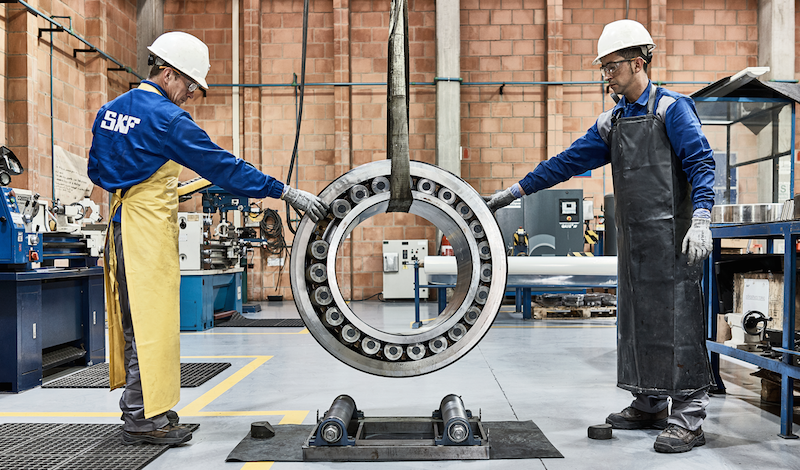HOME >> About us >> Industrial news
Digital technology enables a new approach to an old industrial problem: eliminating the unexpected. As explained by Bernie Van Leeuwen, Director Research & Technology Development at SKF.

In industry, nobody likes surprises. Companies spend much of their time working to create conditions where people, assets and materials behave exactly as expected. The drive for stable, predictable outcomes is at the heart of much modern industrial practice, from statistical process control to lean manufacturing and Six Sigma.

At SKF, our focus is rotating equipment, and the bearings at their heart. Customers come to us because they want products and services that support their reliability, longevity and performance goals. The overwhelming majority of the time, that’s exactly what they get. More than 90 percent of bearings last longer than the machines in which they are installed.
That still leaves room for improvement, however. Wear, fatigue and damage are inevitable facts of life, and machine owners accept that sometimes parts such as bearings will need to be replaced. What they want is the ability to manage this in an orderly manner. Replacing (or re-manufacturing) a bearing during a scheduled overhaul is fine, doing it in a rush after an unplanned stoppage is not.
The predictability challenge
The bearings industry has spent decades researching the problem of predictability. Some of the biggest challenges have been solved. Our understanding of subsurface fatigue, for example, has enabled the development of robust models for predicting the time any bearing can run under within known operating conditions, before its reliability is compromised by accumulated fatigue.
There’s a catch, however. Another thing that decades of experience has taught us is that, in the real world, sub-surface fatigue is the root-cause of failure in less than 1 percent of all bearings. That’s around one in ten bearing failures in service. The other failures are caused by a host of different issues: problems with lubrication, contamination, corrosion or damage from stray electrical currents, for example.
These issues are much trickier to solve. They are the result of unexpected events that can’t be incorporated into simple models or design-time calculations. That doesn’t mean that asset owners need to accept surprise breakdowns as a fact of life, however. Timely, actionable information can turn a potentially expensive problem into a manageable issue. And providing that information is the aim of a major research and product development effort underway at SKF today.
No surprises
Our Predictability work aims to answer three basic types of question for customers:
1. Detection. Is there an issue, or is there likely to be an issue, with my machine?
2. Diagnosis. What is the underlying root cause of the issue?
3. Prognosis. Can I continue to run my machine until its next scheduled maintenance interval? Should I take any action now to preserve its health?
Answering these questions is complicated, because they depend a lot on the specific application in question. Even basic definitions are hard to pin down. In a high-precision manufacturing application, damage to a bearing that leads to a small increase in friction, vibration or play might make a machine unusable. In a simple pump or fan, it might have little effect on overall performance, allowing operation to continue for weeks or months until replacement is convenient.
It isn’t all bad news, however. Advances in technology and changes in industrial practice have given us new ways to tackle this complexity. Our understanding of materials science and tribology continues to evolve, for example, aided by advanced computer-aided modelling and simulation techniques. And most significantly, we now have access to data on real world bearing performance that would have been unimaginable just a few years ago.
The digital dividend
That data comes from the rapid growth in the use of smart sensors and condition monitoring technologies. As part of our Rotating Equipment Performance service offering, SKF collects temperature, vibration and maintenance data from millions of bearings running in thousands of applications around the world. Increasingly, we have the opportunity to supplement that basic information with additional data provided by customers’ own automation and control systems.
We now have new ways of using data too. The development of advanced analytics and machine learning technologies is driving a revolution in our ability to extract new insights from billions of individual datapoints.
Combining rich real-world data with advanced theoretical models is helping us address the problem of predictability from two sides. First, it gives a betterview of how bearings perform in specific applications under specific operating conditions. That allows us to improve the design of our products, and the advice we give to customers on their selection, operation and maintenance.
Second, it is improving our ability to answer those difficult questions for customers: detecting issues earlier, diagnosing them more accurately and predicting their progression with more confidence. As significantly, we can increasingly use advanced computational techniques to automate tasks that have historically required manual analysis by skilled specialists. Over time, we believe that will transform the cost, accessibility and scalability of condition monitoring, predictive maintenance and related approaches.

Where are we today?
The challenge of predictability has not yet been solved, but we have made significant progress, especially in the areas of detection and diagnosis. We have new models and new analytical techniques that perform well in our R&D labs and in tests with customers. Work is now underway to make those approaches sufficiently robust and accessible for wider application. We plan to roll out a number of new tools, products and service offerings over the next two to three years.
And our rate of progress is accelerating all the time. One of the most exciting attributes of the new approach to predictability is the effect of scale. Every new data feed from each sensor-equipped bearing we install helps us to refine and improve our models. That takes us another step closer to our ultimate goal: to provide every customer reliable rotation.
Bernie van Leeuwen,
Director Research & Technology Development at SKF